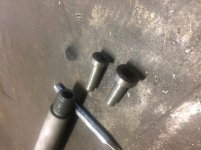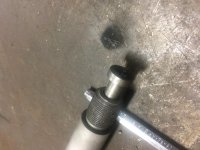I have some parts 7"OD x 1.625 ID X 22 long 4340 PHT. The customer had the 1.625 hole gun drill and the OD turned true to the ID . Wants parts to be within .002 TIR ID to OD when done. No big deal, Ill just rough em and finish between centers. Well first thing I do is set up steady rest to machine in centers and face. Well parts run out about .008 ID to OD. Any one got any solutions to fix this without making some kind of expanding mandrel or something?? Running the parts in a steady rest I really have no way to change the center line of the OD and still maintain the original center line of the gun drilled hole.(did that make sense??)
How to install the app on iOS
Follow along with the video below to see how to install our site as a web app on your home screen.
Note: This feature may not be available in some browsers.
You are using an out of date browser. It may not display this or other websites correctly.
You should upgrade or use an alternative browser.
You should upgrade or use an alternative browser.
Correcting ID to OD runout
- Thread starter cpifer3
- Start date
- Replies 15
- Views 3,105
number 2
Hot Rolled
- Joined
- Aug 13, 2009
- Location
- Western Australia
ID make up a neat fitting bung with a centre hole true to the diameter of the bung to fit the gun drilled hole. Put it in, turn the first 2" or so on the tail stock end,turn part, true to cut section in chuck with bung in other end, and that should be pretty close. Check live centre runout on the shaft of the centre, with the job on the centre to ensure the chuck is not introducing some runout via poor clamping.
Last edited:
Thanks 2, I was thinking of something like that but the face is not square to the bore (rough saw cut), but after reading your description I think I can just face the end as I already have it in the steady rest and proceed as you described , Thanks. Any one else have any tricks?
I'd just chuck the od close to the end, true the id, cut a center and face the end. Turn end for end and repeat. But thats with a 10" thru hole.
I have done smaller pieces by marking the runout on the od and chucking between centers by just putting the center in the gundrilled hole and spinning the part to make sure I got the marked runout. If not, give it a quick tune-up with a die grinder and try it again. When it runs true, cut a seat for a steady rest. But I get your parts at about 225#, so multiple chuckings doesn't sound like much fun.
Another possibility is to make a cat head for the steady rest fingers to ride on, but dialing them in isn't any fun either.
I have done smaller pieces by marking the runout on the od and chucking between centers by just putting the center in the gundrilled hole and spinning the part to make sure I got the marked runout. If not, give it a quick tune-up with a die grinder and try it again. When it runs true, cut a seat for a steady rest. But I get your parts at about 225#, so multiple chuckings doesn't sound like much fun.
Another possibility is to make a cat head for the steady rest fingers to ride on, but dialing them in isn't any fun either.
akajun
Stainless
- Joined
- Jul 1, 2011
- Location
- Brusly, LA
Do it like a gun barrel, several options. 4 jaw, center on ID, face each end. Next make false centers that slip fit the inside of the bore on both ends , then insert them and turn between centers.
Other option is to make a Cathead chuck that you can use to center the ID in two points, then face and turn od for half of length, then flip part and do the other end.
Other option is to make a Cathead chuck that you can use to center the ID in two points, then face and turn od for half of length, then flip part and do the other end.
I'd just chuck the od close to the end, true the id, cut a center and face the end. Turn end for end and repeat. But thats with a 10" thru hole.
That's cheating. I'd love to have a spindle bore that large. I feel lucky most of time just to have 4 1/8 .
Not sure what you mean by cat head. Is that like a sleeve with set screws? Hate to sound stupid but I don't know??
There are no chamfers machined in the ends for centers and the part is rough saw cut on the ends ( not square to OD)If I could get the id to run true using the steady rest I would face it and cut a seat for a center and do just as you have suggeted, but with the od running out to the id I need to approach it in different way.I MUST have missed something!!! Do you not have a tailstock? Run between centers and use a drive dog? Like I said I must have missed something.
R
Not sure what you mean by cat head. Is that like a sleeve with set screws? Hate to sound stupid but I don't know??
Nothing stupid about not knowing.
Yes, a cat head for a steady rest would be a sleeve with 4 set screws on each end, with enough room between the two sets of set screws for the fingers or rollers on your steady. They can be a pita to get adjusted true, especially the first couple of times.
There are no chamfers machined in the ends for centers and the part is rough saw cut on the ends ( not square to OD)If I could get the id to run true using the steady rest I would face it and cut a seat for a center and do just as you have suggeted, but with the od running out to the id I need to approach it in different way.
OKay I sort of get my misunderstanding, but I think you are too concerned about what the OD is doing. Face and Chamfer off the ID location, so dial in the ID as close as you can, turn it slowly while machining, so you don't have the part jumping all over in the steady, but use the steady rest to dial in the ID. Even if you need to remove the top-rest of the steady just to get the ID right. I doubt that at .008" TIR its going to be walking around in your steady that much anyway, but hell I'm wrong regularly. I would try getting the ID dialed in using the steady first.
R
plastikdreams
Diamond
- Joined
- May 31, 2011
- Location
- upstate nj
The customer had the 1.625 hole gun drill and the OD turned true to the ID .
Sounds as though this isn't the case...I'd let the customer know first off.
If the hole is with tight tolerance I would attempt at turning "bung" for the tailstock end and tight-fitting plug with big 4 to 6" "face plate" to a chuck side.
Depending how much you need to turn off from the OD you might be able to simply rely on friction drive between chuck side "face plate" and the work piece.
If the hole tolerances are all over the board then you would need expanding mandrel style both chuck side and tailstock side "bung".
Even if you have to make expanding mandrels it sounds like attractive option in case that you have more than a few pieces to work with. For 1 or 2 pieces you might as well fiddle around with 4-jaw, spider/cat head steady rest and whatnot.
Depending how much you need to turn off from the OD you might be able to simply rely on friction drive between chuck side "face plate" and the work piece.
If the hole tolerances are all over the board then you would need expanding mandrel style both chuck side and tailstock side "bung".
Even if you have to make expanding mandrels it sounds like attractive option in case that you have more than a few pieces to work with. For 1 or 2 pieces you might as well fiddle around with 4-jaw, spider/cat head steady rest and whatnot.
Sounds as though this isn't the case...I'd let the customer know first off.
This was step number one. The first ? I asked before taking on the job was, "do you have a reference turned to the ID" so when I found out it was not, my first call was to the customer. Apparently no one checked it.
akajun
Stainless
- Joined
- Jul 1, 2011
- Location
- Brusly, LA
This is a cathead chuck, this one is mounted on a d15 plate but you can grip them in a 4 jaw too. No steady rest needed on the chuck itself but you may need one on the material if it sticks out too much.
Other option , and what would be better for you is false centers. I use them to turn barrels between centers
Other option , and what would be better for you is false centers. I use them to turn barrels between centers
Attachments
Mike C.
Diamond
- Joined
- Nov 25, 2004
- Location
- Birmingham, AL
Going to require a couple of extra times handling the work, but.... Measure runout on OD and mark it on the work a few inches in (will be opposite of reading if you are running in the steady and indicating ID). Spin it around and grab with four jaw. Dial it to your readings (NOT zero!). Cut a steady rest pad a couple of inches wide. Repeat on the other end. Face and center in the steady after indicating to the tailstock quill. Repeat on the other end. Turn between centers. Used to fight this kind of crap all the time on rolls at the chrome shop.
Done such work. Faces not turned first is the mistake. Now you better make them square to ID by aligning them optically on a grinder. Yeah, you peep through the bore, it’s astonishingly precise. After that you shouldn’t have any burrs around the bore so that you can pick the parts up on the sharp bore edges between centers. You might end up ODs within 0.001 inch.





